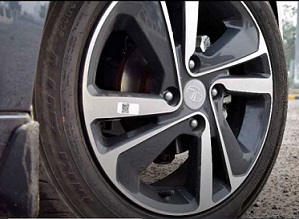All the different types of car tires and tire markings are explained.
Here are all the different types of car tires
Types of Car Tires:
All-season Tires:
Automobile tires are available in a variety of designs and
sizes. You would have to pick which tire would best suit your needs. The tire
you require will change depending on what you use your automobile for and how
you drive it. The type of tire you should purchase is also determined by the
weather. Different vehicles would necessitate the use of different tires.
Your tire selection will also be influenced by whether you
desire more grip or stability on the road. If you prefer high-performance
tires, you may replace the factory ones with these. Because tires impact the
performance of your vehicle, pick your tires carefully. Here are a few examples
of tires.
Standard Tires:
They are designed for regular weather conditions and offer
better grip on both dry and wet roads. These tires feature larger tread blocks
than all-season tires. Furthermore, in the rain, normal tires are more
resistant to hydroplaning. When a film of water becomes trapped beneath the
tire, it causes hydroplaning.
Summer tires are another name for standard tires. They are
so-called because they are useless if the temperature falls below seven degrees
Celsius. Summer tires, however, perform poorly when compared to winter tires.
Winter Tires:
Winter tires are safer to use than ordinary tires when
driving in snow or ice. Because of the heat in the nation, ordinary tires may
be used all year. However, if you live in one of the few colder areas where
snow and ice are prevalent in the winter, you will need to invest in winter
tires.
Winter tires include more silica than summer tires. These
tires would provide the car with increased traction in the snow. They also have
a larger tread pattern and sipes, which means they have better traction on wet
surfaces.
All-Terrain Tires:
All-terrain tires are commonly used on SUVs and other
utility vehicles with four-wheel drive. All-terrain (A/T) tires work well on
the city's asphalt roads. They also perform effectively off-road, regardless of
the terrain.
Lugs are the raised portions on the treads of a tire.
Because A/T tires have thicker lugs, they create a lot of friction.
Touring Tires:
These are high-quality tires. Touring tires are typically
seen on premium vehicles. These tires are ideal for city driving and frequently
have a speed rating of S or T. Furthermore, they are not particularly loud.
Many of these touring tires are also all-season. It means you won't have to
change to winter tires when December rolls around.
Performance Tires:
Even when the car is traveling at high speeds, it delivers
the best traction and road grip. Even when turning, performance tires make you
feel more secure. They have a variety of tread patterns and are typically found
in sports automobiles.
Radial Tires:
Tires are also classed as radial or diagonal based on how
the plies are stacked on top of each other. Plies in radial tires are
positioned to overlap each other perpendicular to the tire's rotational
direction. Tires are most often made of the radial structure.
Diagonal Tires:
Plies in diagonal tires are positioned diagonally at a
55-degree angle to the tire's center line. In the tire, the nylon cords are
positioned diagonally. Bias tires are another name for them. Bias-ply tires are
ideal for vehicles that must transport a large amount of heavy freight.
Explanation of Tire Markings:
The sidewall is a repository for tire information. When you
need to get new tires for your automobile, be sure that the specifications of
the car maker meet what the new tire offers. Let us now examine all of the
marks on the tire.
The tire size order:
The tire size code is the most crucial indication of the
sidewall of the tire. As an example, consider a tire with dimensions of
185/55R16. Many tires would have the letters LT or P etched on them before the
code. LT and P are abbreviations for Light Truck and Passenger, respectively.
The tire application indicates which vehicle it may be installed on.
The breadth of the sidewall is 185.
The width of the tire's sidewall is specified in
millimeters.
The aspect ratio is 55.
We would need to look at the aspect ratio to get the
sidewall height from the tire marks. We may deduce that 111.75mm is the
sidewall height, which is 55% of the tire width (185mm).
R: The tire's construction
The tire in the photo is made of radial rubber. That is, the
plies are positioned perpendicular to the rotating axis. The majority of tires
are radial in design. Tires are also labeled with the letters B or D to
indicate their construction. B and D are abbreviations for Bias and Diagonal,
respectively. Bias plies tires contain layers of rubber-coated sheets arranged
at an angle to the axis of rotation. As a result, by analyzing the tire marks,
we may also learn how the tires are made.
16: The circumference of the rim
It is precisely what it appears to be. The rim diameter is
the diameter of the wheel on which the tire is mounted. The diameter of the rim
is provided in inches. This Bridgestone Ecopia tire in the photo should be
mounted on a wheel with a diameter of at least 16 inches.
Speed Rating and Load Index:
These are often provided following the tire size sequence.
The greatest weight a vehicle can pull is four times the weight of a single
tire. As a result, the automobile with these Bridgestone tires can tow a total
of 1900kg. As a result, always remember to obtain the proper tire for your car.
When purchasing new tires for your vehicle, keep the load index in mind.
The maximum speed that a tire can handle is specified by its
speed rating. You should select tires with a speed rating that is equal to or
greater than the speed rating of your vehicle. The speed rating is represented
by an alphabet. Each letter represents the maximum speed that the tire can
bear. You may always consult the owner's handbook to determine what type of
tire you need to install. The car with 83H tires has a top speed of 210km/hr.
Similarly, here are some of the commonly seen alphabets that
are used to speed rating. Each of the alphabets corresponds to a certain speed.
Speed Rating |
Maximum Speed (Km/hr.) |
|
L |
120 |
|
M |
130 |
|
N |
140 |
|
O |
150 |
|
P |
160 |
|
Q |
170 |
|
R |
180 |
|
S |
190 |
|
T |
200 |
|
U |
210 |
|
V |
240 |
|
W |
270 |
|
Y |
300 |
Additional Tire Labeling:
Consider the maximum load rating, maximum allowable
inflation pressure; tread wear number, and other factors.
Maximum Load Capacity:
The load rating informs you the same thing as the load
index. That is the maximum weight that the tire can support.
Maximum Inflation Rate:
It is the maximum amount of air pressure that the tire can
tolerate. However, you should not inflate the tire to this level. This is because the recommended inflation pressure for your tire will be
lower. You'll most likely find it in the handbook.
The number of tread wear:
The higher the tread wear rating, the longer it will take
for the tires to wear out. The tread wear figures, on the other hand, would be
brand specific. In that instance, we cannot anticipate the same performance from
two different types of tires that have the same tread wear number.
Traction Grade Tires are classified as AA, A, B, or C based
on their traction on wet terrain. The traction grade of a tire indicates how
far it will drive even after you press the brakes in rain. Greater traction
means a speedier stop.
Temperature Level:
Tires with higher temperature ratings can withstand the
greatest heat. Tires with a temperature grade of A will not be harmed at higher
temperatures.
The year of production:
The tire marks also indicate when it was manufactured. We
can determine the year of manufacturing as well as the week it was manufactured.
Conclusion:
This Concludes everything on all types of tires and which
tire suits best for your vehicle.








0 Comments